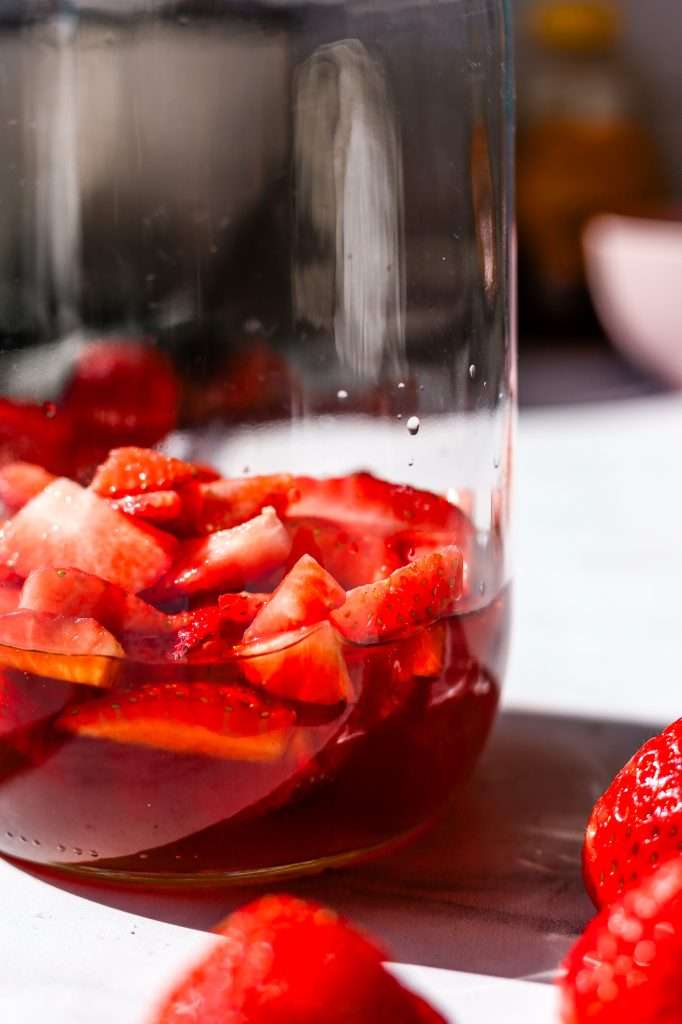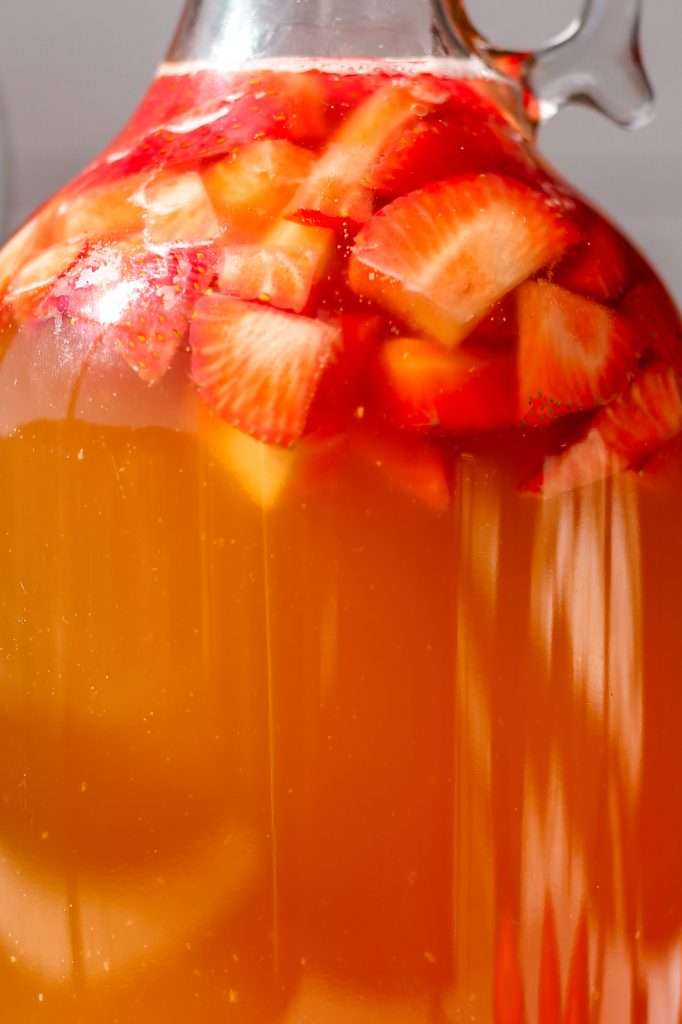Craft your own Strawberry Mead with our easy recipe! Blend apple juice, fresh strawberries, raw honey, and yeast for a delicious, lightly sweet homebrew.
Table of Contents
Strawberry Mead
Mead, often referred to as “honey wine,” is one of the oldest alcoholic beverages known to humanity, spanning thousands of years. Its origins are difficult to pinpoint due to its ancient roots, but there is evidence of mead in various early cultures worldwide, including Asia, Europe, and Africa.
The simplicity of its primary ingredients—honey, water, and yeast—meant that early civilizations could make it. Historical records and archaeological finds suggest that mead could have been made and consumed as far back as 7000 BC in Northern China and around 2800-1800 BC in Europe.
As for its health aspects, mead, like other alcoholic beverages, can have beneficial effects on health when you consume it in moderation.
In moderation, mead made with raw honey can offer some health benefits due to the nutrients found in honey, including antioxidants, vitamins, and minerals. Honey is known for its antimicrobial and anti-inflammatory properties. The healthfulness of mead can also vary depending on the specific recipe and any additional ingredients, such as fruits in melomels, which can add further nutrients and antioxidants.
Nonetheless, consuming mead in moderation is essential, recognizing it primarily as a cultural and gastronomic experience rather than a health product.

Mead with Fruit (Melomel)
Melomel is a type of mead made with fruit added to the fermentation process alongside the primary ingredients of water and honey.
Adding fruit imparts a range of natural colors and flavors to the mead and can influence its sweetness, acidity, and aroma, creating a diverse spectrum of taste profiles.
Strawberries, cherries, raspberries, blackberries, and blueberries are popular choices, but you can use virtually any type of fruit to make melomel, offering endless possibilities for customization.
Melomels provide a delightful way to explore the art of mead-making with the added dimensions of fruit flavors, making them a favorite among novice and experienced brewers.

My Strawberry Mead Recipe
I have a riddle for you: If mead is alcohol fermented with honey, cider is alcohol made from fermenting apple juice, and melomel is mead made with fruit juice, what do you call apple juice fermented with honey? LOL, it’s called Cyser.
Cyser is both a mead (melomel) made with apple juice and a cider fermented with honey.
This strawberry mead recipe is one of my all-time favorite homebrews because the ingredients are extremely simple. I mean, it doesn’t get easier than five ingredients!
Here is everything you need to make a half-gallon of this apple strawberry mead (cyser):
- 48 fl oz apple juice
- 16 fl oz filtered water
- 350 Grams strawberries
- 75-100 grams honey
- 2 grams cider yeast (or 2 tablespoons wild yeast starter)

Mead Brewing Supplies
If this is your first time making strawberry mead at home, I highly suggest starting with a half-gallon recipe like this. This lets you get acquainted with the process and taste test before committing to a large batch.
Here is my Amazon list for brewing supplies. If you have a local home brew store, that is also an option to get what you need.
I got all my supplies at my local homebrew store up the street from my house. At a homebrew store, you can have someone help you pick out the right supplies and proper fitting airlocks. Please note that these links change sometimes, so you need to verify that the lids and airlocks you buy fit the jug you buy.
- 1/2 gallon glass jug (with a cap)
- a second 1/2 gallon glass jug (with cap)
- 1 rubber stopper for brewing – You will need to make sure it is the right size for your jug. Some jugs have different diameter openings. I’ve linked the size stopper that fits my 1/2 gallon glass jug.
- an S airlock for the stopper
- a funnel
- large pot for boiling
- cheap vodka (for cleaning equipment)
- Two 1-Liter swing-top bottles (carbonation safe, for bottling the mead)

Choosing Yeast for Mead
You can use champagne yeast or cider yeast for all my cider, wine, and mead recipes. If you visit a home-brew store, they should be able to help you select a yeast. I really love this Cider Yeast from Mangrove Jack’s too.
When buying packaged yeast, I like to make sure that the yeast species is not genetically modified. We chose to use Saccharomyces bayanus. This yeast species is associated with the natural fermentation of grapes, and it’s great for any mead fermentation.
Another option is to use wild yeast. You only need about two tablespoons of wild yeast starter in place of the yeast in the recipe. Click here to learn how to make a wild yeast starter.

How to Bottle and Carbonate Apple Strawberry Mead
Bottling and storing strawberry mead is pretty straightforward. It would help if you verified that you have carbonation-safe bottles.
To carbonate mead in the bottle, we must add a small amount of sugar, priming sugar, right before bottling. I like to use honey as priming sugar because it contains a lot of fermentable fructans—more fructans = more bubbles.
The yeast will feed on the freshly added sugar and produce more carbon dioxide. Since the mead is in carbonation-safe bottles with the cap secure, the CO2 is forced into the mead and becomes carbonated. Bottling 1 liter with only one tablespoon of honey is not enough sugar to excessively carbonate. It’s just enough to produce a pleasant level of carbonation.
To make this a still strawberry mead instead of sparkling mead, do not add any honey or sugar when you bottle it.
You’ll need:
- Two 1-Liter Swing top bottles(Carbonation Safe)
- Organic Honey
How to Bottle
- Clean and sterilize the bottles.
- Add one tablespoon of honey to each 1-liter bottle. (side note: I like to add in a splash of lemon juice when I bottle to round out the flavor.)
- Using a funnel, transfer the mead from the aging jug into the carbonation-safe bale top bottles, leaving the sediment in the bottom of the jug.
- Cap the bottles and invert gently twice to mix the honey with the mead.
- Allow to ferment at room temperature for five to seven days, then immediately place in the fridge. You can age the mead for three more weeks in the fridge before enjoying it chilled.


Homemade Apple Strawberry Mead (Strawberry Cyser)
Craft your own Strawberry Mead with our easy recipe! Blend fresh strawberries, raw honey, and yeast for a delicious, lightly sweet homebrew.
- Prep Time: 10 minutes
- fermentation time: 2 weeks
- Total Time: 336 hours 10 minutes
- Yield: 64 fl ounces
- Category: Mead
- Method: Fermentation
Ingredients
- 48 fl oz apple juice
- 16 fl oz filtered water
- 350 Grams strawberries
- 75–100 grams honey
- 2 grams cider yeast (or 2 tablespoons wild yeast starter)
Instructions
- Clean and sanitize all of your equipment. I like to wash the jug with soap and water, allow it to air dry a bit, then rinse the jug with cheap vodka and air dry fully. (vodka isn’t a means of sanitation; it only helps with water evaporation)
- Once your equipment is prepped, add the strawberries, water, and honey to a pot, and bring to a simmer. Cook for about 15 minutes; while simmering, mash the strawberries a little with a spoon.
- Remove from heat and place a fine mesh colander over a pitcher or bowl; strain out the strawberry pulp and collect the liquid.
- Allow the strawberry liquid to cool, then, using a funnel, add it to the 1/2 gallon jug. (optional: add an extra cup of washed fresh strawberries to the jug)
- Add in the cider yeast and mix gently by swirling. Wait about 30 minutes for the yeast to get frothy and active.
- In the meantime, heat the apple juice until simmering. Remove from heat and allow to cool to room temperature.
- Carefully using a funnel, add the apple juice to the jug leaving two inches of headspace (see pictures above).
- Cap the jug and swirl it around for about a minute.
- Remove the cap and place the airlock and stopper in the jug (see pictures above).
- After a few hours, you should notice a lot of bubbling in the mead and activity in the airlock.
- Allow the mead to ferment for 7 to 14 days until the bubbling completely stops, and you no longer see any activity in the airlock. At this point, you should see a lot of sediment in the bottom of the jug.
- Racking the mead: Remove the airlock and, using a funnel, transfer the mead to a new, clean jug for aging. Be careful pouring; pour gently and in one steady pour, leaving the sediment in the bottom of the original jug.
- Cap the jug with a regular lid. Allow the mead to age at a cool room temperature or in the fridge for four weeks.
- At this point, you can rack the mead again with more aging time or move on to bottling.
- To Bottle the mead with honey: Clean and sterilize two 1-liter carbonation-safe bottles. Add one tablespoon of honey to each 1-liter bottle. Transfer the mead from the aging jug into the carbonation-safe bottles using a funnel, leaving any sediment in the bottom of the jug. Cap the bottles and invert gently twice to mix the honey with the mead.
- Allow to ferment in the bottles at a cool room temperature for five days, then immediately store in the fridge. (check the carbonation by carefully opening a bottle over the sink, if it is not carbonated enough, you can leave it at room temperature for seven days.)
- You can age the mead for 3 more weeks in the fridge before enjoying it chilled. Keep refrigerated.
Notes
- concerning bottling: I like to add in a splash of lemon juice when I bottle to round out the flavor. I usually add about 1 tablespoon to each 1-liter bottle (optional)
- Be sure to open the bottles to release the pressure occasionally when stored in the fridge for long periods. This isn’t a huge concern; bottling 1 liter with only one tablespoon of honey is not enough sugar to excessively carbonate.
- sugar content varies depending on bottling with honey




